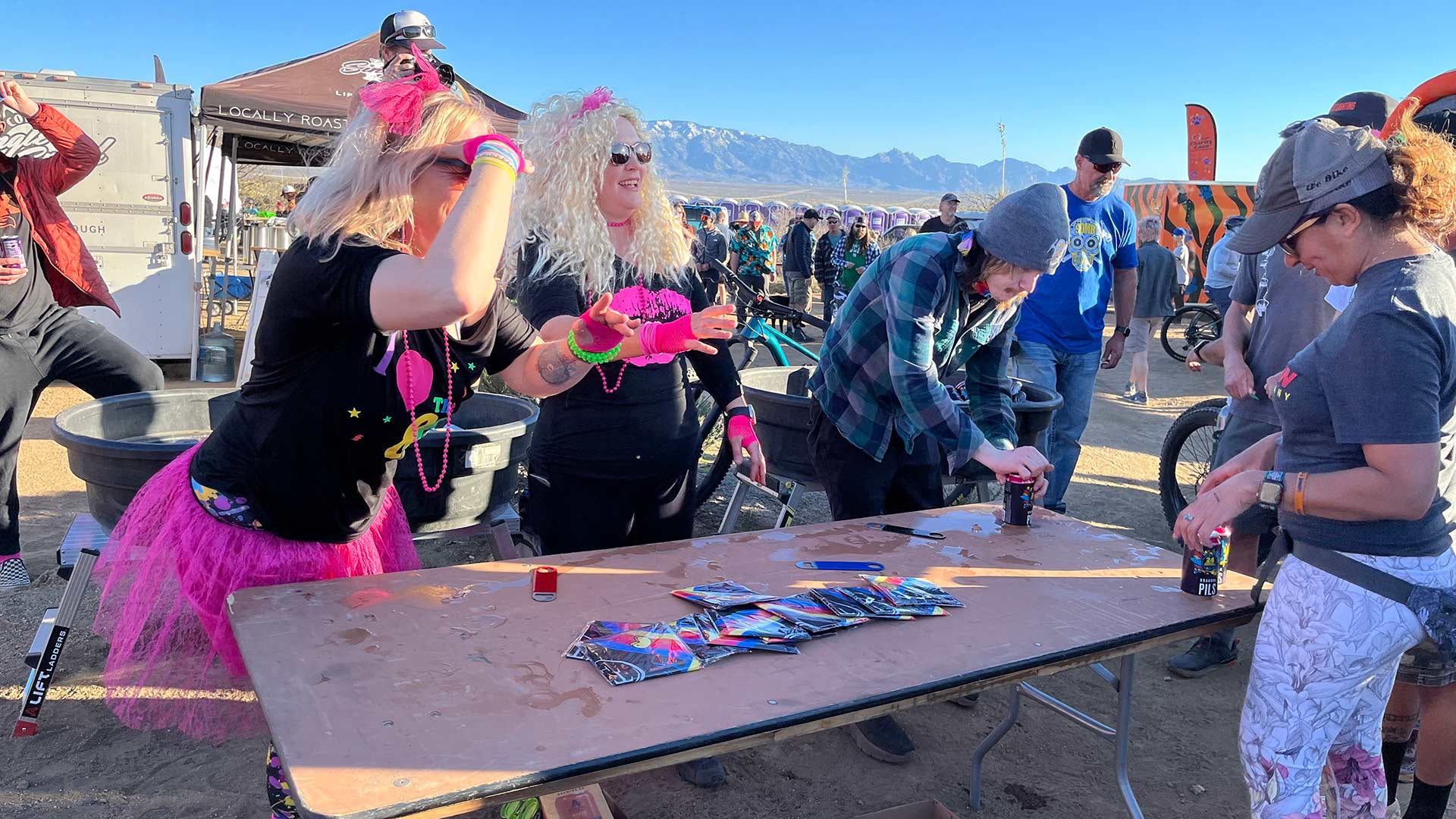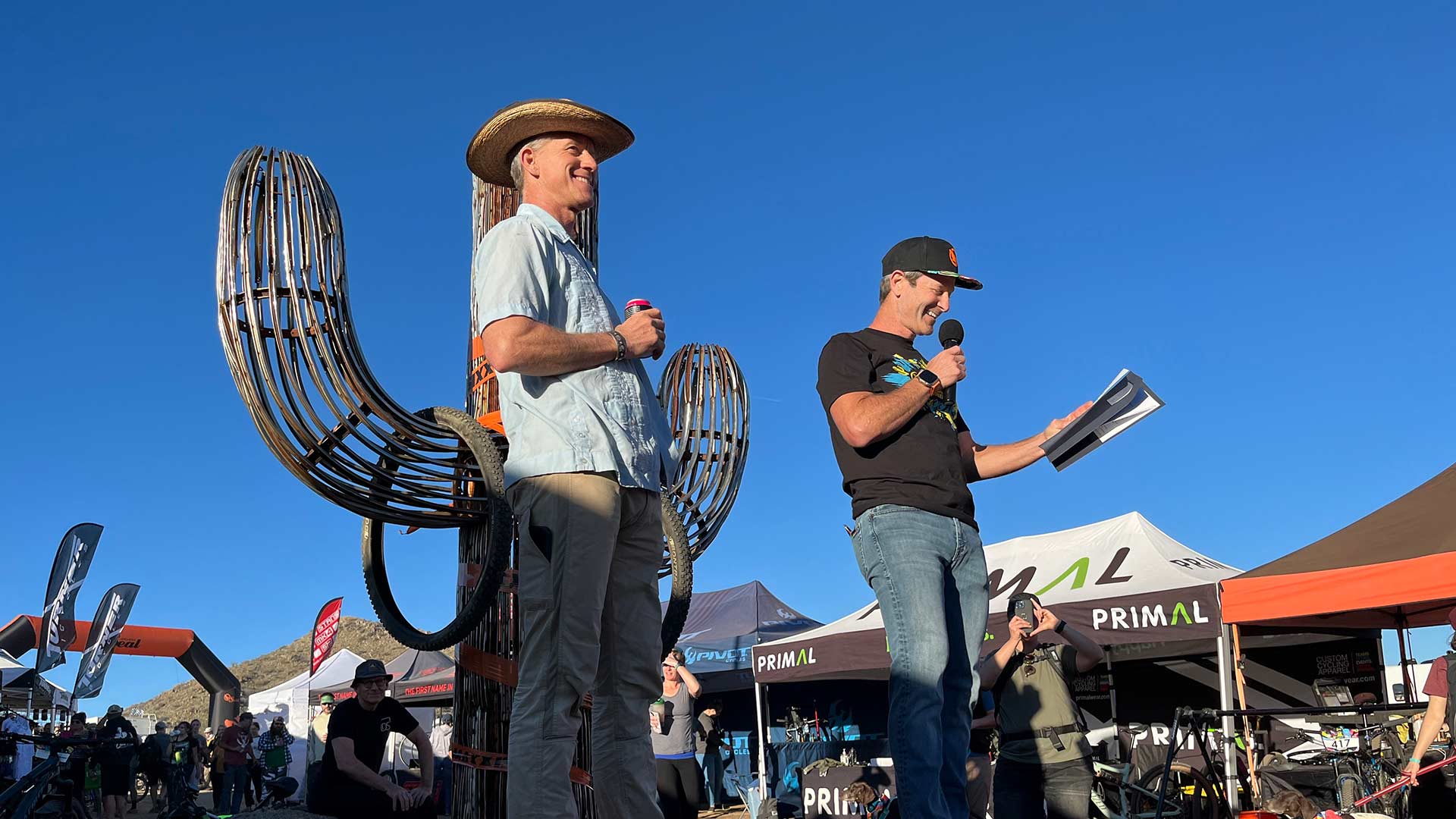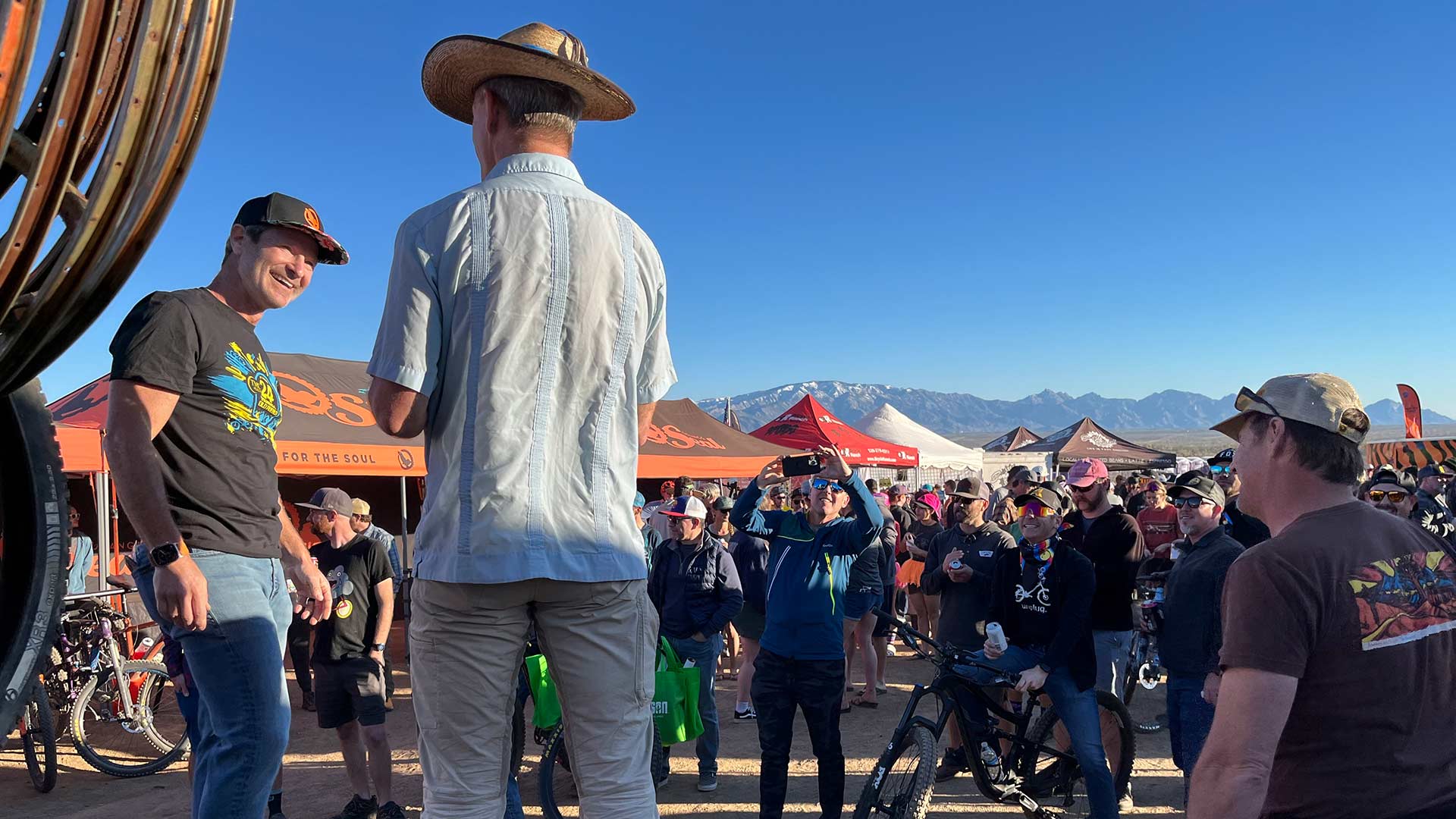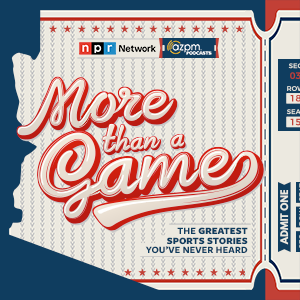More Than a Game, Season 2 Episode 2

On this episode, two stories about mountain biking in Arizona.
We head to a 24-hour relay mountain biking race that brings a temporary town of 4,000 to the Pinal County desert each year. Then we talk to some of the people behind a film that documents efforts to grow the sport on the Navajo Nation, and why some see it as an important sport for reconnecting people with the land.
More from More Than a Game
Episode Transcript:
(Music starts)
I'm Tony Perkins and this is More Than a Game, the podcast that takes you beyond the box score and tells the Arizona sports stories you've never heard.
On this episode, we hit the trail at a 24-hour mountain bike relay race, and learn about efforts to grow that same sport in one of the state's most remote areas.
[music fades]
Every February, about an hour north of Tucson and 11 miles down the dirt road to the remote Willow Springs Ranch, 4,000 people gather at the makeshift 24-Hour Town, bringing with them thousands of mountain bikes.
TMC Health 24 Hours in the Old Pueblo celebrated its 24th year of 24-hour mountain bike relay racing.
The pseudo town is a half-square mile with food vendors, beer gardens, porta potties, showers, dozens of bike-industry representatives, and an around-the-clock exchange tent where racers pass off the baton to their teammates.
 VIEW LARGER Women hand out beers at TMC Health 24 Hours in the Old Pueblo on Friday, Feb. 16, the day before the race.
VIEW LARGER Women hand out beers at TMC Health 24 Hours in the Old Pueblo on Friday, Feb. 16, the day before the race.
Surrounding that are camping areas and the 16-and-a-half-mile course where cyclists will race — either alone or passing off a baton — for 24 hours straight.
AZPM’s Danyelle Khmara went to see for herself.
Danyelle: Bicycle relay races were spreading when Todd Sadow co-founded 24 Hours in the Old Pueblo bike race in 2000, as mountain bikers looked for ways to make their passion even more interesting.
Todd Sadow: “It started to expand as a sport from specifically just riding a bike, and most of the races were an hour or two, and then it kind of leaned toward endurance, so when the endurance theme popped up, 24-hour racing really played a big piece of that because you could ride your bike nonstop for 24 hours, and why not be as extreme as possible?”
 VIEW LARGER 24 Hours in the Old Pueblo founder Todd Sadow and Arizona Trail Association executive director Matt Nelson make a toast on Friday, Feb. 16, the day before the race.
VIEW LARGER 24 Hours in the Old Pueblo founder Todd Sadow and Arizona Trail Association executive director Matt Nelson make a toast on Friday, Feb. 16, the day before the race.
DK: Todd says that the team environment (fade in people chatting and partying) catapulted 24 hour relay racing into the limelight of cycling. It was approachable by groups of friends and it scratched their endurance itch.
About 98% of the cyclists at 24 Hours in the Old Pueblo are amateur riders, and the entire course is rideable so that even a beginner — perhaps with a little grit — can stay on their bike the entire course.
The race has numerous categories, including teams of two to 10 people, as well as soloists, some who will ride nearly nonstop for 24 hours.
 VIEW LARGER People cheer after a toast to the race and the Arizona Trail, led by 24 Hours in the Old Pueblo founder Todd Sadow and Arizona Trail Association executive director Matt Nelson on Feb. 16.
VIEW LARGER People cheer after a toast to the race and the Arizona Trail, led by 24 Hours in the Old Pueblo founder Todd Sadow and Arizona Trail Association executive director Matt Nelson on Feb. 16.
Tyler Pearce: My goal is to have less than an hour stop time. So ride, not as hard as you can, but as long as you can…”
DK: Tyler Pearce is in the solo male category, and traveled here with his 13-year-old son as part of a three-week road trip from Yosemite where they live.
Tyler: “The vibe so far here is unlike anything that can be explained. This doesn’t feel like a bike race but it is. This is what playing bikes really is. We’re making s’mores at night, we’re getting rowdy, music’s playing, we’re in a beautiful desert, the weather is phenomenal. But then also you get to be competitive. And that’s always the hard thing with any bike race, is how do you blend your child-like amazement of riding bicycle with your — I’m taking this way too seriously as an adult who’s not really a professional — right? And this is that. This is blending that so perfectly.”
(Fade in sounds of partying) — “Raise your cans high and let’s celebrate.” Everyone cheers
DK: It’s Friday, the evening before the race, and 24-Hour Town is popping. People grab beers out of a trough of ice, greet old friends and talk to bike-industry vendors.
There’s a line to try to land old bike tires over a towering saguaro cactus made out of recycled bicycle rims by the nonprofit BICAS. Bikes navigate with ease through the growing throng of happy people.
 People line up to try and land an old tire on the BICAS cactus.
People line up to try and land an old tire on the BICAS cactus.
Registration for the event opens every year on Oct. 1 and sells out in about an hour or two, with people traveling from nearly every state in the country and other parts of the world.
By tomorrow there will be 4,000 people here — 2,000 vendors and bike industry presence, crew members and friends and family there to support — and 2,000 participants, who at noon on Saturday will start the event with a Le Mans-style run to their bikes.
The founder Todd talked to a group of media at the event with the generator that keeps it all going running in the background.
TS: “Everyone is so excited right now, and everyone is so excited tomorrow until 2 in the morning. OK, now we need our game face. So that’s the night time hours. The exchange tent at 3 in the morning. The mile long stares from people waiting for their teammate that are just like — my last teammate didn’t go out. I’m going out for the next lap. I’ve already done six laps. I think I’m having fun; I’m not sure if I’m having fun. I don’t know what I’m doing with my life anymore. … [laughs]
DK: 16-year-old Lily Lingard did two of her laps in the dark last year, with the last one finishing at nearly 4 a.m.
LL: “It was not fun. Like when you’re out there there’s a lot of uphill and you just keep thinking how you can’t wait for the lap to be done because in the moment it’s not a lot of fun but it’s such an accomplishment when you finish. It’s definitely worth it in the end.”
And her team won last year — the 4-person team women's category. Lily is here with her mom, who first got her into cycling, and her dad and younger sibling, who is wearing a full-body cow costume — just for fun.
“Just cause it’s fun, and I’m going to help my mom be a greeter at 3:30 … cute, talking with their parents about ow it’s hot inside the costume
DK: This is a weekend-long party, but it’s also an intergenerational family event. Participants' ages range from 12 to 78. And over a 10 year period, 80% of participants will come back.
The event also has a fundraising component and for the weekend turns into one of the area's largest community food drives, collecting about two tons of canned goods.
As well, each year the race has a dedication recipient, and this year it’s the Arizona Trail Association, the nonprofit that maintains the National Scenic Trail that runs 800 miles from the Utah border to Mexico, and one of the only that allows mountain bikes.
And when the event is over, Todd explains they tear down 24-Hour Town and leave the Willow Springs Ranch better than they found it, which is why they’ve been invited back for so many years.
Todd founded this event and the event management company for mountain biking Epic Rides when 24-hour racing was taking off.
TS: In the early 2000s, there were somewhere between 75 to 100 24-hour races in America and who knows how many worldwide. It faded away quite a bit. So there’s only a few 24-hour races left in America and maybe 2 or 3 times that in the world. So it’s not as popular as a format, but this one for whatever reason has really withstood the test of time. It continues to thrive.
Man to the crowd: “Who’s ready to have a lot of fun this weekend?” People cheer. “Let’s hear it for Epic Rides and the whole crew that helps make this event possible. This is my favorite weekend of the whole year.” Cheering, music fading in.
For More Than a Game, I’m Danyelle Khmara
Tony Perkins: Mountain biking continues to grow in popularity, with one industry group saying nearly nine million people took part in off-road rides in 2022, that number is up from around six million in 2007.
While growth in the sport is often seen in the natural areas around cities, groups are pushing for its growth in some of the most rural parts of the country too.
One such place is the Navajo Nation, where a handful of non-profits are working to put tribe members young and old on bikes. That effort is the subject of a new documentary.
More Than a Game's producer Zac Ziegler has that story.
[film audio]
Biking culture in the Navajo Nation, I never knew it existed. There was a culture that started, a little fire that started. This ridership that started, there's different connections throughout the reservation. It's like going to a sweat lodge, you know? We go pray and get all the bad stuff out of us. That's how it is for me when I ride the bike. It's hope. Mountain biking on the reservation, there's a cultural side of it. The bicycle rides bring people back to the land.
Zac Ziegler: That's how In the Dirt kicks off, laying out some of the reasons why this group of devoted people are working to bring the sport of mountain biking to the Navajo Nation.
Their aim is to get more people exploring the 27,000 square miles of reservation land on two wheels.
T.C. Johnstone: What made me interested in this in the first place was it was a hopeful story."
ZZ: That's In the Dirt's director, T.C. Johnstone.
TJ: It was something that I had never heard before. And a lot of the stories that I was seeing that I was seeing within the Native American communities were not about things that were positive, or that were about what we're for, not what we're against. And I think those are more helpful. As far as thinking about where we're going, not necessarily where we've been, we have to address that too. But there's more to the story."
Among the people he met while learning that story was a mountbiker and trail-builder from Leupp, Arizona.
[Terrence Yazzi's introduction in Diné]
Terrence grew up bouncing between his home in Flagstaff and the spot where generations of his family lived in Leupp, about an hour's drive northeast of Flagstaff.
TY: "I just got fixated on spinning wheels. A lot of different people, you know, have their own relationship with cycling and it looked strange to me as a kid. I'd see people like on really skinny bikes, you know, and really skinny tires. And I've seen people on little tiny wheels in the skate parks, and mountain bikes and everything, adventure bikes, and my friends did it. But what really bought me in was, you know, getting my wheels off the ground."
ZZ: He started out on a B-M-X bike. As an adult, he's settled into life in Leupp on his family's land. Terrence and his partner, M-T, are both featured in the documentary.
They have put effort into increasing where people can ride on the reservation.
TY: So, we're trying to advocate for development of trail systems and you know, not necessarily for an economic purpose, but more to fulfill the need. And I guess that could take the form of, you know, private Navajo trails, and it wouldn't be a public access.
ZZ: He says it's about trying to build community in a place where the population density is about six people per square mile.
TY: Mountain biking is pretty social as well. Like everybody, if you play well together, you're gonna hang out together. And that's what I want to teach when I do coaching. It's be respectful, let's work together, let's troubleshoot something, let's build something, let's understand where we can build. And maybe places where we should stay off of, you know? Unfortunately, there's uranium pits and certain water sources that are contaminated and you definitely want to keep them away from thinking it's okay to be in those areas for safety.
ZZ: Terence and his company, Yahz Trails, work with groups in the area, like Rezduro, the first Indigenous-led mountain bike enduro-style race, and Silver Stallion, a non-profit out of Gallup, New Mexico run by former professional cyclist Scott Nydham.
A connection to Nydham was how T.C. Johnstone came to this story.
TJ: I met Scott. And that story goes back to Rwanda, Africa, actually. I did a film called Rising From Ashes about the first cycling team in their attempt at the Olympics. It was a bunch of genocide survivors and Scott just happened to be, you know, at the completion of his cycling career. He was volunteering in Rwanda. And so I met him and his wife, gosh, 15 years ago. And then, fast forward. A friend of mine had told me that he was down in Gallup, New Mexico, and here we were.
ZZ: That intrigued T.C. and his wife Kristen, and they began traveling to the area.
TJ: When we went down on a discovery trip, I started to learn that there was a lot that I was probably going to be exposed to, or I was going to learn along the way that would allow me to learn and become a different human being. And that's what I wanted the film to be about was that we would see the world in a new way. And I think a lot of that was that. First off, this story is in our backyard. This isn't Africa, this isn't some foreign place on the planet. This is, a lot of people have driven through the Navajo Nation and have been there.
ZZ: Terrence says helping people find a place to ride is a tricky part, but what can be harder is the work that groups like Silver Stallion are doing, getting people access to the gear.
TY: So, mountain biking is a pretty expensive sport. It can get definitely pricey. So some people have taken donations, some people I've worked with work with people like at Outride, Specialized or Trek Foundation. Entities like that, they provide that access and for myself, and some of those people like Claudia, Scott Nydam and Mr. Jon Yazzie. We definitely take those bicycles and a coaching perspective and we apply it to teaching interested parties.
ZZ: That's Claudia Jackson, a race organizer and member of the nearby Holbrook Unified School District Board, known to many as “the bike lady,” and Jon Yazzie, who runs a bike-packing tour company, Dzil Ta’ah Adventures. They're among the many people who are pushing for this effort.
I asked Terrence why he does this work and what he gets out of mountain biking.
TY: It keeps me humble. It's a thing of physics, something I don't quite understand, but I can observe what it does. And when I go out for a bike ride, depending on my mood, sometimes I'm hammering, sometimes I'm shredding, sometimes I'm at skate parks, sometimes I'm just out pedaling. But it allows me to think.
ZZ: He mentioned a conversation we had before I started recording where we both talked about not being a fan of long drives on interstate highways.
TY: It's got, you know, got too much focus that you need to be worried instead of just being on the back roads, and I'm on a bike, any bike, you know, I really don't care as long as the wheels spin. But I just feel more clarity, I suppose. You know, like, some things aren't as big deals.There are and some things definitely need more time to be evaluated so I definitely like the bike gives me a moment to breathe.
ZZ: The drive out to Leupp lets you see why he feels like that. You transition from the mountains and pine trees of Flagstaff and the Coconino National Forest into the high desert and open space that makes up much of Navajo tribal land.
Terrence says he'd love to see where he lives become a mountain bike haven. He thinks about some mountain bike hot-spots, including a trip he took to Bentonville, Arkansas, a place that Outside Magazine called Disneyland for Mountainbikers. That transformation came largely thanks to money from the Walton Family Foundation.
TY: I've seen people bought in. I've been to Sedona. I've been to Moab. I've seen the entire economic development of mountain biking in my hometown. But I go to Bentonville and I see something else completely different. I see a vision that only a few are giving effort to. And it's amazing. It's a community that's really geared towards mountain biking and cycling access in general. And I know it gives me something, a vision to build towards. I don't know if the reservation will accept it. They have their own perception of what they want to do. And I'm just one dude, you know. When I go to the Chapter Houses, and whenever I speak to politicians, I keep just reminding them, 'I'm just a voter, just a Navajo dude.'
ZZ: He says it doesn't have to be a transformation that makes the Navajo Nation a tourism haven like the spots he mentioned. He'd just like to see more places for those like him to get out and connect with the land and each other.
For More Than a Game, I'm Zac Ziegler.
[music fades in]
Tony Perkins: In the Dirt's next Arizona screening is on March 30 as part of the Flagstaff Mountain Film Festival. It's also available online at Inthedirtfilm.com.
And that's it for this episode of More Than a Game.
Join us next time as we head to the rodeo, and take one last trip to the PAC-12 men's basketball tournament.
The show is produced and mixed by Zac Ziegler.
Our News Director is Christopher Conover.
Our logo was designed by AC Swedbergh.
Thanks to our marketing team for their help in launching this podcast.
This show is part of the AZPM podcast family. You can find all of our podcasts, news and video productions at azpm-dot-org.
I'm Tony Perkins, we'll see you next time.


By submitting your comments, you hereby give AZPM the right to post your comments and potentially use them in any other form of media operated by this institution.